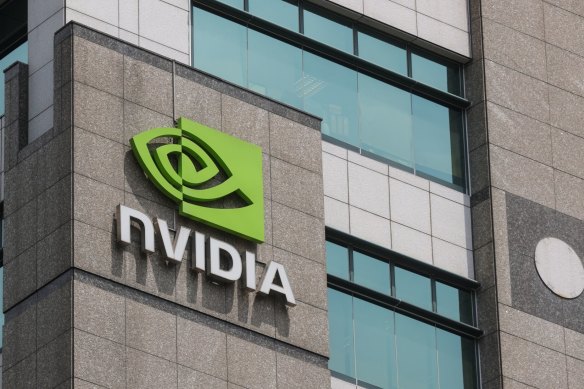Lessons from an Nvidia investor: Stay cool and use common sense
Opinion
August 6, 2024 — 12.12pm
Shares in the technology giants (and everything else) have dropped dramatically in the US this week, with computer chip designer Nvidia notably falling substantially on fears that the AI frenzy is a fad. That’s not my view, which is to either sit tight, or buy up any emerging bargains if you can.

Indeed, I’m holding on to my Nvidia shares. With a near-monopoly position in making graphics processing units (GPUs) or advanced computer chips that can process complex computing functions such as AI, Nvidia is a cash cow.
When I first bought Nvidia shares, I was struck by the importance of advanced computer chips or GPUs for enabling the digital age.Credit: Bloomberg
It is one of the largest companies in the US, with a market-leading position protected by the US government, which is doing everything it can to keep advanced computer chips out of China. The company enjoys huge profit margins of about 100 per cent and its profits are up by more than 600 per cent in its first-quarter FY25 results. I expect more good things to come.
The bottom line is that the digital age is here to stay. And it is a long journey, so I’ve jumped on board by investing in quality technology companies that dominate their marketplaces, such as Nvidia.
That guided my decision to first invest in Nvidia in 2022, when I bought the stock for myself and my children as their fund manager in one of the company’s worst years ever.
I invested at an average of around $US200/share. Nvidia shares are now priced at the equivalent of about $1000 since the 10-for-one split – that’s still a fivefold increase in just two years. Nvidia means “envy” in Italian and that’s an enviable gain.
With the near-monopoly position enjoyed by Nvidia, investors can’t go wrong – or at least they could do a lot worse.
I think now, more than ever, the important thing is for investors to buy quality stocks on dips if they can, which is what I’m doing. Certainly, I am not selling and sealing any losses, as I did buy some tech shares in July and July this year at higher prices.
As the Wall Street Journal put in a headline this week: Stocks Are Crashing – That’s a Great Reason to Sit Tight. “Looking at S&P 500 returns since 1994 shows that selling based on the previous day’s falls is a bad strategy. Electing to move into cash after large monthly declines fared better, but still less well than sitting tight,” the WSJ reported.
Many analysts remain bullish on Nvidia. I, too, expect that Nvidia will continue to post some great earnings results, and that will be a catalyst for future price gains.
Loading
That expectation is governed by common sense; when I first bought Nvidia shares, I was struck by the importance of advanced computer chips or GPUs for enabling the digital age. I bought the stock in several purchases, the average cost of investing about $US200/share and as low as $US180.
It was a safe bet, as I saw it.
The reasons for investing in Nvidia and fellow GPU producer AMD remain very compelling, given that both companies enjoy US government protections, and they sell an essential good: GPUs, with Nvidia holding the dominant market share and no near competitors – yet.
The US too has convinced the Europeans to ban ASML, Europe’s largest technology company, from exporting the machines needed to make advanced computer chips to China. I also own shares in ASML and fellow Dutch company ASM International, which supplies Nvidia and AMD with some of the technology they need to make advanced computer chips.
With the near-monopoly position enjoyed by Nvidia, combined with US government protections, investors can’t go wrong – or at least they could do a lot worse.
Any investor can do it – that is, use common sense to make sound decisions to invest in companies that make goods and services that we all need. I research all options vigorously, checking key details such as market shares, profit margins and earnings growth, all information that is freely available online. I ask important questions, such as: is the market growing? For GPUs, it certainly is.
You may have heard the analogy that computer chips are the “oil” of the 21st century. We need ever-increasing numbers of faster computer chips to serve our digital world, much like the world needed oil last century to drive industrialisation.
While I’ve drawn a comparison between computer chips and oil, it’s a crude analogy.
Oil is a commodity, while GPUs are the product of the world’s most complex manufacturing process – hence the three-month wait time to make one chip, even longer for one of Nvidia’s GPUs.
While the momentum may be gone for the moment, the fundamentals for long-term earnings growth and gains are still there for Nvidia, protected by one of the biggest global institutions of all: the US government.
Nicki Bourlioufas is the director of PR agency, Spot On Content & PR, and is also a finance writer and self-directed investor.
Advice given in this article is general in nature and is not intended to influence readers’ decisions about investing or financial products. They should always seek their own professional advice that takes into account their own personal circumstances before making any financial decisions.Loading









































